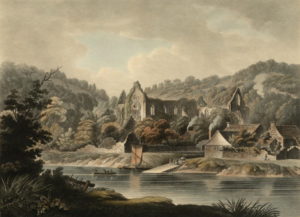丁特恩修道院

第二天早上,我们上了一艘大船,带着两只桨,沿怀伊河而上,来到一个叫廷特恩修道院的地方。 在这里,我们非常高兴地看到了我所见过的最奇特的一片废墟;我不相信你们的巴尔贝克人或帕米拉人能比它多。
致诗人兼园丁威廉-申斯通的信,1760年7月
丁特恩成立于1131年,是萨里郡韦弗利修道院的第一个女儿,也是英国第二个西多会修道院。 它位于怀伊河的峡谷深处,中世纪的历史主要是不平静的。 在1536年它被投降并被萨默塞特家族(后来的博福特公爵)收购后,修道院附近的工业潜力还没有被开发出来--怀伊河提供了电力和水资源。到1556年,这里开始生产铁丝,1607年,第一座高炉开炉,生产出一些 "王国中最坚硬的铁"。 然而,这只是它最持久的篇章的前奏--浪漫的废墟,无数诗人和画家的灵感来源。
 爱德华-戴斯的《怀伊河登陆》,1799年。
爱德华-戴斯的《怀伊河登陆》,1799年。
Dayes捕捉到了废旧的修道院教堂,几乎被绿色植物所笼罩,同时也暗示了附近的工业。 在中间的滑道旁停着一艘方帆货船(tro),附近有工人的小屋。 在右边的树林里,石灰窑里冒出了烟。 未来的桂冠诗人Robert Southey渴望见证 "工业的崇高",他访问了这个地方。1795年的午夜,附近的高炉。
十八世纪中期,人们开始沿着怀伊河从罗斯到切普斯托进行观光旅游。 现在,人们更容易接触到它的野性之美。 1756年,第四任博福特公爵挖掘了教堂,将随之而来的垃圾倒入怀伊河。 地板被恢复到中世纪的水平,并覆盖上光滑的草坪,以改善交通。 缠绕着废墟教堂的藤蔓和常青藤仍然没有被触及。
See_also: 马恩岛1770年,风格大师威廉-吉尔平(William Gilpin)写了一篇怀伊河谷的游记,重点介绍其 "如诗如画的美"。 这里作为形容词使用,吉尔平将帮助把如诗如画这个词变成一个名词,以配合 "崇高 "作为一种独特的审美理想。
See_also: 辞租的仪式在重工业的影响下,修道院的教堂似乎没有受到影响。 吉尔平对公爵的保护尝试并不感冒,他说 "如果这个地区保留所有粗糙的碎片,肯定会更加美丽"。 对吉尔平来说,教堂屋檐的 "规则性""伤害了眼睛",他甚至建议,"明智地使用木槌可以然而,一旦进入教堂,他就对常春藤 "与灰色的石头形成了一个愉快的对比 "和鲜花 "为废墟增添了最丰富的装饰 "而感到欣喜。
修道院为许多穷人提供了临时住所,他们充当 "导游 "以换取救济金。 一位可敬的妇女带领吉尔平来到她在回廊里的 "豪宅",可能是以前修士的图书馆。 吉尔平从未见过 "如此令人厌恶的人类住所"。 它仍然是 "在两面破败的墙壁之间的高高拱起,上面流淌着各种颜色的不健康的露水。 她唯一的家具是'一个可怜的床架'。
 约1815年,廷特恩修道院的大西门,弗雷德里克-卡尔弗特
约1815年,廷特恩修道院的大西门,弗雷德里克-卡尔弗特
阴暗中出现了修道院的废墟,染上了明亮的光线,发现了大量丰富的哥特式工艺;并以令人愉悦的对比展示了废墟所由的灰色石头,以及漂浮在它们周围的羽毛状树叶:但我们没有时间去研究所有这些美丽的部分是如何形成一个整体的--想象力形成了它,经过了视力消失了'。
威廉-吉尔平《怀伊河的观察》 1770年
在接下来的50年里,该地区的浪漫形象与工业一起繁荣发展。 作为一个先驱性的制造基地,怀伊河吸引了那些寻求崇高的人--工业的和乡村的。
夜晚的高炉和Tintern的昼夜运转令人敬畏。 工业只在当时的诗歌和绘画中被提及。 华兹华斯最著名的诗歌之一《写在Tintern Abbey上方几英里处的诗句》(1798年)反映了五年前的一次访问以及他对自然的感知是如何成熟的。 有人认为他忽略了到1828年,熔炉已经消失了--Tintern以木炭为燃料的炼铁工艺已经过时。
 Tintern Abbey: The Crossing and Chancel, Looking toward the East Window by J.M.W. Turner 1794. 这幅作品显示了他作为建筑绘图师的背景,最初是在1792年画的草图,当时他17岁,在南威尔士旅行,为一系列的风景画收集素材。
Tintern Abbey: The Crossing and Chancel, Looking toward the East Window by J.M.W. Turner 1794. 这幅作品显示了他作为建筑绘图师的背景,最初是在1792年画的草图,当时他17岁,在南威尔士旅行,为一系列的风景画收集素材。
1876年,铁路抵达怀伊河谷,为了应付大量的游客,在廷特恩修建了一个大型车站。 1901年,现在被认为是国家重要的纪念碑,国家以15000英镑的价格收购了它。 1914年,工程局接管了监护权。 保护和展示是他们的基本原则。 以前,中殿脆弱的南墙被谴责,但是工程局选择了进行大修。 常春藤是新业主的大忌,因为它掩盖了建筑细节,并有可能破坏本已脆弱的结构。 太多的植被也给人以管理不善的印象。
古建筑保护协会(SPAB)对修道院的修复持反对意见。 该协会的秘书Albert Powys在1922年写道,该建筑 "不再是一件神秘的东西","剥去它的树叶,它的凹处的深色阴影消失了"。 观察者不再感到 "敬畏和惊讶"。 一般来说,浪漫主义者批评了一些人哀叹 "渐进式 "废墟的结束,现在被 "静态 "废墟所取代。
 教堂的西面,其精心设计的十四世纪壁画和常春藤,约1880年。
教堂的西面,其精心设计的十四世纪壁画和常春藤,约1880年。
那些赞成保留常春藤或反对彻底修复的人被认为是自私的--虽然他们可以欣赏废墟的美学品质,但随之而来的破坏可能使后代根本没有机会目睹建筑。 最近的研究更同情常春藤,因为它可以帮助保护墙壁免受极端温度的影响。 因此,保留常春藤而不是被 "根除 "应该是'认为'。
今天由Cadw管理,每年有七万人涌入华兹华斯的 "野性幽静的场景"。
 Tintern Abbey教堂向西看,突出了Cadw仍然坚持的保护和展示的工程办公室的精神。 无植被的废墟呈现在修剪整齐的草坪上,使公众易于进入。
Tintern Abbey教堂向西看,突出了Cadw仍然坚持的保护和展示的工程办公室的精神。 无植被的废墟呈现在修剪整齐的草坪上,使公众易于进入。
作者:理查德-泰勒 我一生都对寺院感兴趣,并参观了英国和欧洲的许多寺院。 我没有正式的历史资格(我的学位是航空航天工程),尽管我已经通过牛津大学继续教育在线完成了各种艺术史课程。 我住在英国的曼彻斯特附近。

